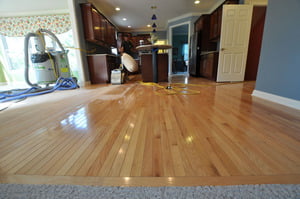You notice that your floor sags and gives as you stroll across it. This should never be construed as a good sign. It always means that something is going on under your house. No matter what it is, it will mean trips under your house if you do not have a basement. More than likely, the problem will be a floor joist problem that may require replacement of the joist. With a basement, fixing this problem will be a little easier, but you will stay much cleaner.
The first step is to get into a place where you can see the bottom of the sub-floor of your house.
This will either be in the basement or in the crawl space. Accessing the crawl space will either be through a port in the foundation of your house or a trap door in a closet or room. Locating this entry for the first time can be a challenge in some houses. Finding the spot where the issue is happening may require a second person to assist you. Have the other person tap where the problem is. This should give you a good idea where to look.
If the floor joist shows damage from insects or other problems, you will need to correct this before replacing the joist.
Termite repair or eliminating issues like water damage may mean that you should bring professionals into the process. This can turn a relatively inexpensive job into a major expenditure, but it is better to correct the problem than to let it continue to grow and get worse. Once the cause of the damage is rectified, you can return to the matter of replacing the defective floor joist.
Determine the size of the joist so that you can by the correct size for replacing it.
Most floor joists will be a 2×8, 2×10, or 2×12. The length will depend on the size of your house. You will be wise to secure 2 bottle jacks that can lift 1,500 or more pounds. The new joist will be easier to slide into place if you can lift the house slightly on each end of the joist.
Getting the new joist under your house may be difficult if you are dealing with a crawl space.
If the entrance to the underneath of your house is an interior trap door to the crawl space, you will have to seek other ways to access the crawl space to slide the new joist inside. Usually, this can be accomplished by removing a covering from a foundation vent and slipping the joist through it. Try to find a way to get it done without cutting the new joist.
Slide the new joist into place on its side beside the joist needing replacement.
On the opposite side of the old joist, use one of the jacks on each end to raise the pressure off of the old joist. If the old joist is solid on both ends, leave it in place. If it is not, you should tap it until it can be removed. Tip the new joist until it is upright and correctly positioned. It will either be adjacent to the old joist or standing up in its place. If the old joist is still there, you can screw the new joist to it to hold the new one in place. If the old one has been removed, fasten the new joist to the wall plate and central beam.
Lower the jacks to let the house rest on the new floor joist.
The new joist should be solidly in place. Go back into the house and verify that this fix has corrected the problem. In some cases, you will want to go ahead and replace an extra joist or two on either side if the sag or weak spot is extensive.





